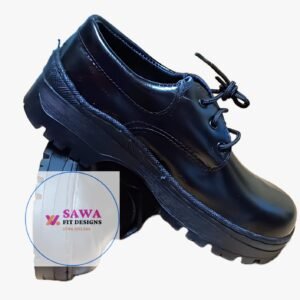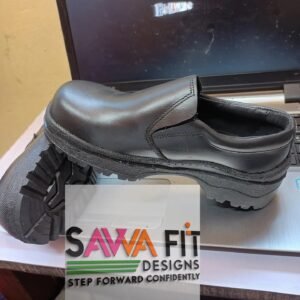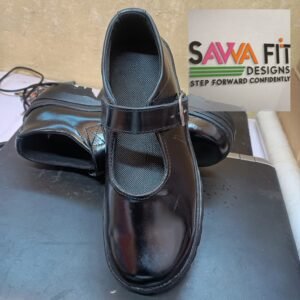Quality school footwear in Kenya
-
Back to School Shoes -Genuine Pure Leather
Original price was: KSh1,300.KSh1,000Current price is: KSh1,000.Select options This product has multiple variants. The options may be chosen on the product pageClear3234242526272829303133 -
Boys Black School Shoes
Original price was: KSh1,500.KSh1,200Current price is: KSh1,200.Select options This product has multiple variants. The options may be chosen on the product pageClear363835373940 -
Slip-On School Shoes Boys
Original price was: KSh2,500.KSh2,000Current price is: KSh2,000.Select options This product has multiple variants. The options may be chosen on the product pageClear323436382728293031333537 -
Girls School Shoes (Buckle)
Original price was: KSh1,800.KSh1,400Current price is: KSh1,400.Select options This product has multiple variants. The options may be chosen on the product pageClear3837
The Essential Guide to Quality School Footwear in Kenya
Every school day, a child embarks on a journey. Whether it involves a short walk to a local primary school or a longer trek across varied terrain, their feet are constantly at work. Selecting quality school footwear in Kenya is a fundamental decision, extending beyond merely choosing a uniform item. It significantly influences a child’s daily comfort, overall health, and capacity to concentrate on their education. Parents consistently prioritize durability, comfort, and affordability when purchasing school shoes. These preferences are not arbitrary desires but practical considerations arising from the demanding realities of daily school life in Kenya. This guide aims to clarify what truly defines quality school footwear and how
sawafit designs shoes specifically to address the distinct requirements of Kenyan students, ensuring children are well-equipped for academic success.
The Profound Impact of Footwear on a Child’s Health and Learning
Poorly fitting or low-quality shoes can lead to a multitude of problems for a child. Beyond immediate discomfort such as blisters and soreness, inadequate footwear can impede proper foot development and contribute to more severe health concerns. In some regions of Kenya, the absence of appropriate footwear can tragically result in debilitating parasitic infections, such as jiggers, which directly prevent children from attending school and fully participating in their education. This highlights that footwear is not just about comfort or uniform compliance, but also a critical public health and educational necessity.
Children spend numerous hours in their school shoes—walking to and from school, sitting in classrooms, and engaging in play during breaks. When their feet experience discomfort or pain, their ability to concentrate on learning is severely compromised. Furthermore, a child’s school shoes face rigorous daily conditions. They must endure the demands of active children, navigating diverse environments ranging from urban streets to rural paths, which are often unpaved and susceptible to dust, dirt, and mud.
The perception that cheaper shoes are always more economical often overlooks hidden, long-term costs. Inexpensive footwear tends to wear out quickly, necessitating frequent replacements that ultimately incur greater expense over time. This creates a fundamental tension in parental purchasing decisions, as the desire for durable shoes to withstand tough conditions and avoid frequent, costly replacements often conflicts with initial affordability concerns. By understanding these long-term financial implications, coupled with the potential health and academic setbacks caused by inadequate footwear, the argument for investing in quality from the outset becomes compelling.
Defining Quality School Footwear: An Essential Checklist
When selecting school shoes, it is important to look beyond the initial price. Focusing on specific attributes ensures comfort, durability, and safety for a child.
Durability and Materials: Built to Last
Shoes must withstand daily wear and tear, particularly given the active nature of children and Kenya’s varied terrains. Parents consistently seek footwear that is durable, long-lasting, and tough. Leather is a highly preferred material, valued for its perceived durability, quality, and traditional aesthetic. Specific preferences for “full-grain leather uppers” or “cowhide real leather” indicate a desire for higher quality materials, which are associated with longevity and resilience. In terms of construction, robust materials, sound construction, reinforced soles, and sturdy stitching in high-stress areas are crucial. Scuff-resistant uppers, whether leather or high-quality synthetics, are also vital for daily use.
Comfort and Support: For Happy, Healthy Feet
Children spend significant hours—typically 6-8 daily—in their school shoes, making comfort an absolute necessity. Key features to prioritize include cushioned insoles for shock absorption during playtime. Breathable linings are essential to keep feet cool and prevent sweat buildup, particularly in Kenya’s tropical climate. Flexible soles are also important, as they allow for natural foot movement, a feature especially critical for younger children. Growing feet require proper arch and heel support. A firm heel counter provides stability and helps maintain proper foot alignment. Additionally, torsional stability, where the shoe resists twisting in the middle, offers crucial support during lateral movements.
Fit and Safety: Secure Steps
A proper fit is paramount. It is recommended to measure both feet regularly, as sizes can differ slightly and children’s feet grow quickly. There should be a thumb’s width of space at the toe for growth, and heel slippage should be minimal (less than 5mm) to prevent chafing. Ill-fitting shoes can lead to issues such as blisters, ingrown nails, or long-term posture problems. Secure closures like laces, Velcro, or buckles are important to prevent tripping on loose straps and ensure stability during activity. Non-slip soles are also vital for safety on various surfaces, especially on muddy walkways during rainy seasons. Reflective elements can further enhance visibility.
Ease of Maintenance: Practicality for Parents
Practicality in maintenance is a key consideration for parents. Shoes with wipeable surfaces that can be easily cleaned with a damp cloth are highly desirable. Water-resistant properties are beneficial for keeping feet dry in light rain or accidental spills. Removable insoles are also a valuable feature, as they allow for easy washing and drying, contributing to hygiene and extending the shoe’s lifespan.
The concept of quality in school footwear is not uniform; it adapts to a child’s developmental stage and the increasing demands of school life. For early years, shoes that are easy for children to put on and take off independently, offer plenty of wiggle room for toes, and have a wide toe box are important, while excessive cushioning should be avoided for proper sensory development. For primary school children, scuff-resistant toe caps, machine-washable materials, and good ankle support are beneficial. Secondary school students require shoes that balance style with practicality, offer good arch support as their feet mature, and are of higher quality to withstand the rigors of a full academic year. This nuanced understanding of evolving needs guides the design of footwear that supports children through different school phases. Quality school footwear in Kenya
Table 1: Key Attributes of Quality School Shoes
| Attribute | Why It Matters | Key Features to Look For |
| Durability | Withstands daily wear, saves money long-term. | Genuine Leather, Reinforced Stitching, Robust Soles. |
| Comfort | Prevents fatigue, blisters; aids concentration. | Cushioned Insoles, Breathable Linings, Flexible Soles. |
| Support | Promotes healthy foot development, proper alignment. | Arch Support, Firm Heel Counter, Torsional Stability. |
| Fit | Prevents injuries, ensures stability. | Proper Toe Space, Snug Heel, Measure Regularly. |
| Safety | Prevents slips and falls. | Non-Slip Soles, Secure Fastenings, Reflective Elements. |
| Maintenance | Easy to keep clean and presentable. | Wipeable Surfaces, Water-Resistant, Removable Insoles. |
Introducing SAWAFIT: Crafted for Kenyan School Life
At sawafit, the unique demands placed on school shoes in Kenya are well understood. The brand was founded on an unwavering commitment to quality, durability, comfort, and affordability, merging the rich heritage of leather craftsmanship with contemporary design.
Sawafit is a trusted destination for parents seeking ideal footwear for their children’s academic journey.
Sawafit shoes are not merely generic footwear; they are specifically engineered to address Kenya’s environmental challenges. The water-resistant leather handles rainy seasons, deep tread patterns provide grip on muddy walkways, and reinforced toe caps protect against rocky paths. This localized engineering ensures optimal performance in the diverse Kenyan environment.
High-quality materials are used to ensure longevity. Many sawafit pairs feature genuine leather uppers, making them durable and resistant to daily wear. The soles are typically made from robust rubber, offering excellent grip and preventing slips. The brand prioritizes full-grain leather for its resilience, a highly sought-after attribute among Kenyan parents.
A child’s comfort is paramount in sawafit‘s design philosophy. Sawafit shoes incorporate cushioned insoles that support arches and heels, effectively reducing foot fatigue. Breathable linings help keep feet dry and comfortable, preventing blisters, especially during long school days and warm weather. Many designs even feature memory foam footbeds for superior impact absorption, a feature frequently highlighted by parents.
Children are active, and sawafit shoes are built to endure. Reinforced toe caps and sturdy outsoles make them tough enough to withstand running, playing, and general school activities. The objective is for these shoes to last the entire academic year, providing excellent value for parents.
Sawafit balances quality with competitive pricing, making its shoes accessible to many Kenyan families. While the initial cost might be slightly higher than some imported alternatives, parents consistently find that sawafit shoes prove more economical in the long term due to their superior durability, which minimizes the need for frequent replacements.
Sawafit‘s mid-range pricing typically falls between KSh 1,000–2,000, with some options available for as low as KSh 999 or KSh 500. The brand also offers replacement guarantees for manufacturing defects.
The “Mtumba” (second-hand) market offers an affordable option for school shoes in Nairobi, providing cost-effectiveness and durability from reputable brands. However, this market also carries inherent risks, as parents must inspect shoes for wear and ensure proper fit.
Sawafit positions itself as a reliable, new alternative, offering guaranteed quality, consistent fit, and the peace of mind that comes with new, purpose-built footwear. This approach directly addresses the potential issues of unknown wear and fit associated with second-hand options, providing a long-term cost advantage.
Furthermore, sawafit‘s emphasis on local design and manufacturing extends beyond mere product features. It builds a powerful narrative of authenticity, relevance, and social responsibility. “Local Brands and Manufacturers” are a top search topic for school leather shoes, with sawafit gaining traction for its “quality craftsmanship and support for local artisans”. The manufacturing process utilizes locally sourced materials where possible, which helps keep prices competitive. This strategy aligns with the broader economic context where Micro, Small, and Medium Enterprises (MSMEs) contribute significantly to Kenya’s leather footwear output. By showcasing
sawafit as a high-quality local brand, the company fosters trust and appeals to parents who value supporting local industries, countering historical perceptions of local goods and explaining how competitive pricing for quality products is maintained through local supply chains and labor.
Finding the Perfect Pair: SAWAFIT’s Diverse Range for Boys and Girls
Sawafit offers a wide selection of children’s school shoes that combine style, comfort, and durability. The range caters to various school uniform requirements and age groups, ensuring an ideal fit for every child.
Classic Black Leather Shoes: These remain a timeless choice for both boys and girls, offering versatility, durability, and suitability for formal school settings.6 They often feature streamlined profiles that appeal to older students, mimicking adult formal shoes and fostering a sense of maturity.
Lace-Up Shoes: Ideal for older children who require a secure, adjustable fit and enhanced support. Sawafit lace-up styles provide a classic look with sturdy construction designed to handle active play. These are perfect for children who have mastered tying laces.
Velcro Fasteners: Perfect for younger children or those who need quick and easy fastening. Sawafit Velcro shoes are simple to wear and adjust, promoting independence and simplifying busy mornings.
Buckle Fasteners: A classic, neat option frequently seen on girls’ shoes. Sawafit‘s buckle-fastened models allow for adjustable tightness, accommodating different foot widths and providing a secure fit.
Slip-On Shoes: Convenient for younger children who have not yet mastered laces. Sawafit slip-ons feature elastic bands for a snug fit and durable outsoles for outdoor activities, offering ease of use without compromising on quality.
School shoes are a mandatory element of the school uniform, often with strict regulations prohibiting open shoes or casual footwear. Simultaneously, children desire to feel confident in their footwear, and stylish designs can help them express their personality. Teenagers, in particular, appreciate designs that resemble adult formal shoes. This creates a dynamic where
sawafit‘s range provides options that meet both strict uniform requirements (e.g., classic black leather, closed-toe designs) and a child’s desire for comfort, style, and ease of use (e.g., adjustable buckles, easy Velcro, streamlined profiles). By offering a variety of compliant styles, sawafit caters to the multifaceted needs of both parents (adherence to rules, durability) and children (comfort, age-appropriate style, independence in fastening).
Table 2: SAWAFIT School Shoe Styles and Features
| Style | Ideal For | Key Benefits |
| Classic Black Leather | All students, formal settings | Timeless, versatile, durable, adheres to dress codes. |
| Lace-Up | Older children | Secure, adjustable fit, classic look, strong support. |
| Velcro | Younger children | Easy to wear & adjust, promotes independence, quick fastening. |
| Buckle | Girls, younger children | Classic, neat option, adjustable tightness, secure fit. |
| Slip-On | Younger children | Convenient, easy on/off, snug fit with elastic, durable. |
Smart Shopping Tips for Kenyan Parents: Maximizing Value
Making an informed purchase ensures that an investment in quality school footwear yields true value.
Buy Early: Avoiding the last-minute rush in January by purchasing shoes well in advance helps secure the correct sizes and preferred styles before stock runs low, preventing stress and limited choices.
Prioritize Replaceable Insoles: Opting for shoes with removable insoles allows for refreshing the cushioning annually or as needed, extending the shoe’s comfort and hygiene without replacing the entire pair. Quality school footwear in Kenya
Check Return Policies: Especially when purchasing online, understanding the return and exchange policies is important. Sawafit offers easy returns, providing peace of mind with a purchase.
Measure Feet Regularly and Try On: Children’s feet grow quickly. Measuring their feet every few months and always having them try on shoes before purchasing ensures the right fit. The type of socks a child typically wears should also be considered when trying on shoes.
Long-Term Value Over Initial Cost: A slightly higher initial investment in quality footwear, such as sawafit products, often translates to significant savings over time. Durable shoes mean fewer replacements, less hassle, and consistent comfort for a child, proving more economical in the long run.
Proper Maintenance Extends Life: Simple care routines can significantly extend the lifespan of any quality shoe. Regularly wiping down shoes with a damp cloth to remove dirt, allowing them to air dry naturally away from direct heat, and storing them in a cool, dry place helps maintain their shape and integrity.
Sawafit shoes are designed for minimal maintenance with wipe-clean surfaces.
The convenience of online shopping is a growing trend for school leather shoes, with platforms like sawafit.com, Kilimall, and Jumia being popular choices.
Sawafit‘s commitment to “Countrywide Delivery” and “Secure Payments” (including Mpesa, card, and cash on delivery) directly addresses this consumer shift. By emphasizing the convenience, security, and nationwide reach of its online platform,
sawafit positions itself as a modern, accessible, and trustworthy brand that aligns with contemporary Kenyan shopping habits, offering a hassle-free alternative to traditional market visits.
Conclusion: Investing in Their Future, One Step at a Time with SAWAFIT
Choosing the right school footwear is a crucial decision for every Kenyan parent. It represents an investment in a child’s daily comfort, their long-term foot health, and ultimately, their ability to focus and thrive in their education. Sawafit is dedicated to providing durable, comfortable, and stylish school shoes that are specifically designed for the unique conditions and demands of Kenyan school life. The brand blends quality craftsmanship with affordability, ensuring reliable footwear that offers true long-term value. By prioritizing quality school footwear, parents contribute to a child’s well-being and academic journey.
Quality school footwear in Kenya
-
Back to School Shoes -Genuine Pure Leather
Original price was: KSh1,300.KSh1,000Current price is: KSh1,000.Select options This product has multiple variants. The options may be chosen on the product pageClear3234242526272829303133 -
Boys Black School Shoes
Original price was: KSh1,500.KSh1,200Current price is: KSh1,200.Select options This product has multiple variants. The options may be chosen on the product pageClear363835373940 -
Slip-On School Shoes Boys
Original price was: KSh2,500.KSh2,000Current price is: KSh2,000.Select options This product has multiple variants. The options may be chosen on the product pageClear323436382728293031333537 -
Girls School Shoes (Buckle)
Original price was: KSh1,800.KSh1,400Current price is: KSh1,400.Select options This product has multiple variants. The options may be chosen on the product pageClear3837
Quality school footwear in Kenya



